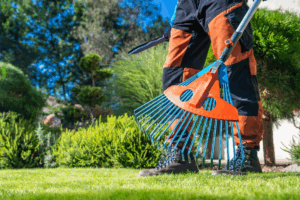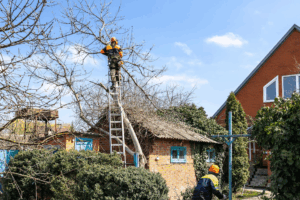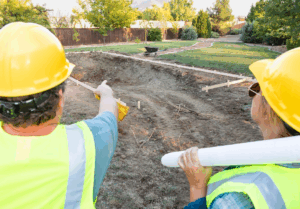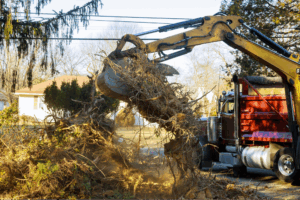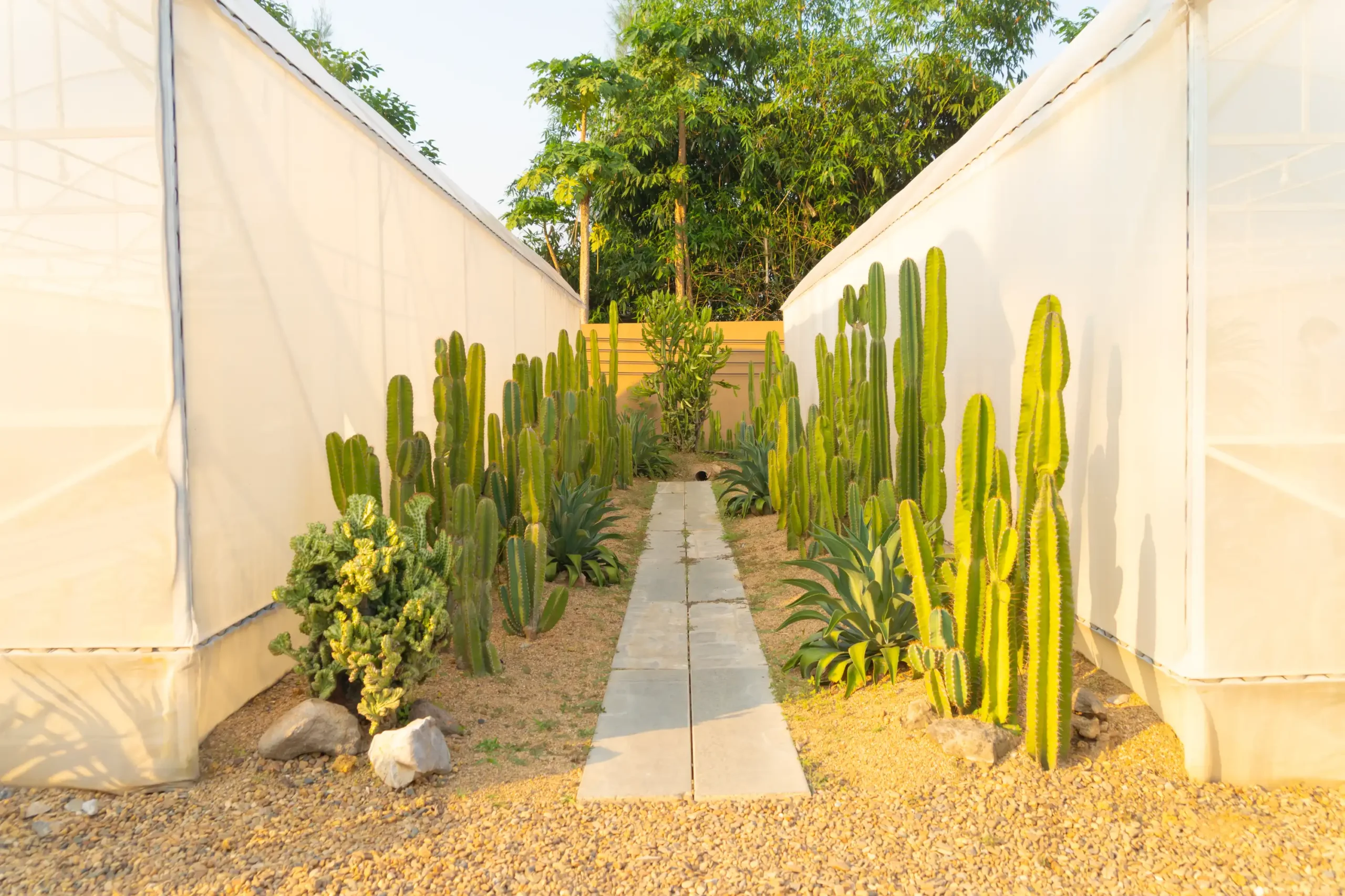Many homeowners dream of a beautiful yard but struggle with dry, arid conditions. Traditional landscaping relies on thirsty lawns and plants that demand constant care. In desert climates, that approach leads to high water bills and endless maintenance. Fortunately, new landscaping ideas blend sustainability with style, making creating a stunning outdoor space easier. These strategies help transform any yard into a thriving, low-maintenance desert retreat.
Best Desert Landscaping Ideas and Trends for 2025
A well-designed desert landscape enhances curb appeal while reducing water waste. In 2025, landscaping trends will focus on sustainability, minimal upkeep, and natural aesthetics. More homeowners are replacing lawns with drought-tolerant plants, creative hardscapes, and smart irrigation, which brings fresh solutions for those looking to upgrade their outdoor space.
Sustainable Xeriscaping for Water Conservation
Xeriscaping remains one of the best solutions for desert-friendly landscaping. This technique uses native and drought-resistant plants that thrive with minimal watering. Layering mulch around plants helps retain moisture and prevent soil erosion. Smart irrigation systems deliver water directly to roots, reducing waste. Combining these elements allows homeowners to create a beautiful yard without excessive water use.
Drought-Tolerant Plants for a Lush Look
Many assume desert landscaping means sacrificing greenery, but that’s far from the truth. Succulents, cacti, and native shrubs thrive with little water while adding texture and color. Flowering plants like lantana and desert marigolds brighten up spaces with vibrant blooms. Agave and yucca provide striking architectural elements that require little upkeep. A mix of plants creates a visually diverse yard that looks full and lively.
Hardscaping With Natural Stone and Gravel
Hardscaping plays a crucial role in water-efficient landscapes. Natural stone pathways and gravel beds replace thirsty lawns while enhancing the yard’s structure. Large boulders serve as focal points, creating contrast with soft greenery. Using locally sourced materials ensures harmony with the desert environment. These elements add depth and character while keeping maintenance to a minimum.
Modern Desert Garden Features
Sleek and minimalist designs dominate desert landscaping trends. Geometric layouts and raised planters add structure without overwhelming the space. Dry riverbeds mimic natural waterways, creating visual interest without requiring water. Outdoor seating areas with shade structures enhance functionality and comfort. These features help blend modern aesthetics with the rugged beauty of the desert.
Smart Irrigation Systems for Efficiency
Traditional sprinklers wastewater in dry climates, but technology offers better solutions. Drip irrigation systems target plant roots, ensuring efficient water use. Smart controllers adjust watering schedules based on temperature and soil moisture. Sensors prevent overwatering by detecting real-time conditions. These innovations reduce waste, lower costs, and simplify plant care.
Outdoor Living Spaces With Desert Charm
A well-designed yard isn’t just about plants—it should also be livable. Pergolas and shade sails provide relief from the sun, making outdoor areas more comfortable. Fire pits extend the usability of patios, creating a cozy atmosphere at night. Rustic wooden furniture and natural clay elements blend seamlessly with the surroundings. These additions turn an ordinary yard into a welcoming outdoor retreat.
Edible Desert Landscaping for Practical Use
Functional landscaping is gaining popularity as homeowners seek sustainable options. Fruit trees like pomegranates, figs, and citrus thrive in arid climates. Herbs such as rosemary, thyme, and sage require little water and enhance home cooking. Raised garden beds improve soil retention and allow better water management. Combining edible plants with decorative elements adds beauty and practicality to any landscape.
Desert Meditation and Zen Gardens
A growing trend in desert landscaping is incorporating meditation and Zen-inspired spaces. These gardens use raked sand, sculptural boulders, and minimalist plant arrangements to create a peaceful retreat. Small water features like stone basins or recirculating fountains add a soothing ambiance without excessive water use. Simple seating areas with natural materials encourage relaxation and mindfulness in a desert setting.
Colorful Desert Landscaping With Bold Accents
While desert landscapes often feature neutral tones, many homeowners embrace bold color schemes. Vibrant ceramic pots, painted walls, and mosaic pathways add personality to outdoor spaces. Flowering desert plants like the Mexican bird of paradise, red yucca, and penstemon provide striking color contrasts. Decorative metal sculptures and artistic stonework further enhance visual interest. This approach makes the landscape feel vibrant and inviting while maintaining a desert-friendly design.
Native Grass Alternatives for Ground Cover
Traditional lawns don’t thrive in desert climates, but native grasses offer a sustainable alternative. Drought-tolerant grasses like blue grama, buffalo, and sand lovegrass require minimal water and maintenance. These grasses create a soft, natural ground cover that blends with the desert landscape. Many homeowners mix native grasses with wildflowers to create a meadow-like effect. This alternative keeps the yard looking lush while conserving water.
More Desert Landscaping Ideas for 2025
The future of desert landscaping prioritizes sustainability, functionality, and aesthetics. As homeowners move away from high-maintenance lawns, they embrace innovative solutions that make their outdoor spaces more enjoyable and eco-friendly. In 2025, new trends focus on alternative ground covers, vertical gardening, sustainable lighting, and climate-conscious design. These additions enhance the landscape while conserving resources and blending with the natural environment.
Low-Maintenance Artificial Turf Alternatives
Many homeowners are moving away from traditional grass due to its high water consumption. In 2025, artificial turf will continue to be a popular alternative, but new eco-friendly options are emerging. Permeable ground covers like decomposed granite, crushed rock, and desert moss provide a natural look with minimal maintenance. These alternatives offer durability, reduce water use, and blend seamlessly with desert environments. Choosing the right ground cover creates a practical and visually appealing yard.
Desert-Themed Vertical Gardens
Vertical gardens are gaining popularity in desert landscaping. They maximize space, reduce heat retention, and add greenery to walls and fences. Hardy succulents, air plants, and drought-resistant vines thrive in vertical planters with minimal water. Many homeowners incorporate living walls near patios to enhance outdoor aesthetics and improve air quality. Vertical gardening is a space-saving solution that introduces greenery without compromising efficiency.
Solar-Powered Outdoor Lighting
Sustainable lighting is a major trend in desert landscapes. Solar-powered pathway lights, lanterns, and wall fixtures enhance safety and ambiance without increasing energy costs. Motion-sensor LED lights provide security while being energy-efficient. Homeowners also incorporate solar torches and string lights to create a cozy evening atmosphere. These lighting solutions highlight landscape features while embracing renewable energy.
Natural Windbreaks for Climate Control
Desert environments often experience strong winds and intense heat. Natural windbreaks, like strategically placed trees, shrubs, and stone walls, help regulate airflow. Palo Verde, mesquite, and desert willow trees provide shade while acting as wind barriers. Gabion walls and stacked stone fences add structural protection while complementing the landscape. These elements make outdoor spaces more comfortable and energy-efficient.
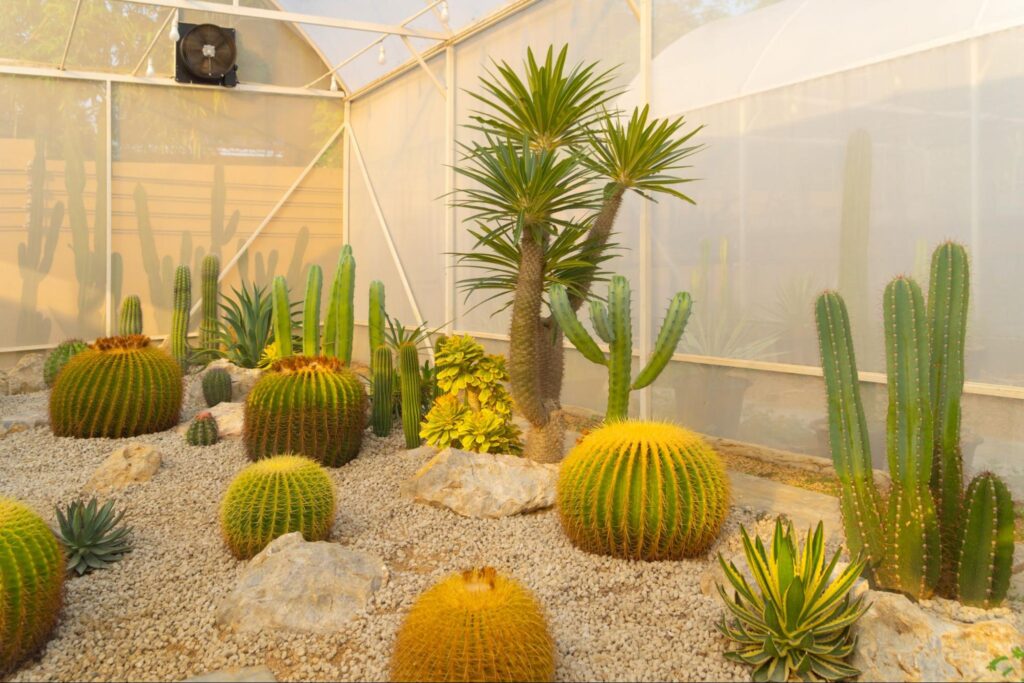
Wildlife-Friendly Desert Landscaping
Creating a habitat-friendly landscape is a growing trend for eco-conscious homeowners. Native plants attract pollinators like butterflies and hummingbirds, supporting local ecosystems. Birdbaths, small ponds, and bee-friendly flowers enhance biodiversity. Low-water ground covers provide shelter for beneficial insects and small desert wildlife. These design choices help maintain ecological balance while adding natural beauty to the yard.
Permeable Paving for Water Management
Water runoff is a concern in desert environments, especially during rare but intense rainstorms. Permeable paving, such as porous concrete, decomposed granite, or permeable pavers, allows rainwater to seep into the ground instead of creating runoff. This solution helps recharge underground water sources while preventing erosion. Many homeowners use these materials for driveways, walkways, and patios to maintain a natural look while improving water efficiency.
Fire-Resistant Landscaping for Desert Safety
Wildfire risks are increasing in many dry regions, making fire-resistant landscaping necessary. Fire-resistant plants like red yucca, desert spoon, and succulents add greenery while minimizing fire hazards. Hardscaping elements such as stone walls, gravel beds, and concrete patios act as firebreaks, slowing the spread of flames. Spacing plants apart and maintaining clear zones near structures further enhances fire safety. These landscaping strategies provide peace of mind while maintaining a stylish outdoor space.
Rainwater Harvesting for Sustainable Irrigation
Many desert homeowners are turning to rainwater harvesting to maximize water efficiency. Collection systems capture rain on rooftops and store it for future use in gardens. Barrels, underground tanks, and dry wells help reduce reliance on municipal water sources. Pairing rainwater harvesting with drip irrigation ensures plants receive adequate moisture while minimizing waste. This eco-friendly solution is a wise investment for long-term sustainability.
Shade Structures for Outdoor Comfort
With intense desert sun, shade structures make outdoor spaces more enjoyable year-round. Pergolas, ramadas, and shade sails provide relief while adding architectural interest. Many homeowners opt for wooden or metal pergolas with climbing vines like jasmine or passionflower for natural cooling. Large canvas sails create flexible shaded areas over patios and seating spaces. These features improve comfort while enhancing the overall look of the yard.
Functional Rock Gardens for Erosion Control
Rock gardens aren’t just decorative—they also serve a practical purpose in desert landscapes. Arranging rocks in varying sizes helps prevent soil erosion, especially in sloped areas. Pairing rocks with drought-tolerant plants like sedum, agave, and desert daisy creates a natural, low-maintenance design. Using different colors and textures of stones adds depth and contrast to the garden. These functional features enhance durability while blending seamlessly with the surrounding environment.
Multi-Level Desert Landscaping for Small Yards
Not all desert landscapes have large open spaces—many homeowners need compact designs that maximize small areas. Multi-level gardens use retaining walls, tiered planters, and sunken seating areas to create depth. Raised beds help organize plant groupings while improving drainage. Desert-friendly stairs and pathways connect different levels for a seamless look. This approach is perfect for small backyards, patios, or sloped properties where space optimization is key.
Bring Your Desert Landscaping Ideas to Life
A desert landscape isn’t just about rocks and drought-tolerant plants—it’s a statement of resilience, creativity, and harmony with nature. Your choices today will shape an outdoor space that thrives for years. Whether you embrace native plants, integrate smart irrigation, or design a shaded retreat, your yard can be stunning and sustainable. With professional landscaping services, you can bring your vision to life with expert guidance and precision. The desert offers a blank canvas, and the right landscaping ideas will transform it into something extraordinary. Step outside, reimagine your space, and start creating a landscape that truly belongs to you.
Get inspired by the latest trends in desert landscaping. Visit the J. Christie Landscape blog for more ideas!

